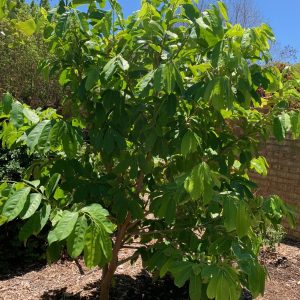Lucuma (Pouteria)multiflora
Caimitillo, jacana, bully tree
Origin
Neotropics – Jamaica, Puerto Rico, Lesser Antilles and northern South America.
Climate
It is found in wet humid lowland rainforests and up to elevations of 2000m, generally with evenly distributed rainfall of 1400-3000mm pa. However it can survive relatively dry seasonal periods for 2-4 months once established.
Plant Description
In native areas, jacana is a large evergreen tree up to 35m high with a grey-red-brown trunk and diameter at breast height of 60cm. Trees have a strong taproot and numerous laterals sometimes seen above ground. The spiral glabrous, chartaceous and obolanceolate leaves with an acute base on a 1-3cm petiole are 9-30 X 3-10cm. Plant parts contain copious sticky white-creamy latex.
Relatives
There are about 250 species in Pouteria which belongs in the Sapotaceae family of about 1250 species. Valued fruiting relatives include Mamey and green sapote, abiu, canistel, lucuma, star apple and sapodilla.
Soils
It is not particularly fussy about soils, and while it can grow on limestone & igneous rocks it does best in sandy clay loams with pH 4.5-7.
Propagation
Propagation is by seeds which are recalcitrant. Fresh seeds take 3-10 weeks to germinate with success rate usually better than 50%. Germination is hypogeal phanerocotylar, and stronger growth is obtained under shade than in full sun. Seedlings can grow to 50cm in 6 months, after which they can be in-ground planted. Vegetative propagation is difficult, and even with misting and bottom heat might only give a 20% success rate.
Cultivars
This species is still in the undeveloped wild state as no horticultural or scientific breeding work has been undertaken.
Flowering and Pollination
Inflorescences are 2-6 flowered axillary fascicles with 0.5-1cm pedicels. The pale greenish-cream scented flowers are bisexual with 4 sepals, a cylindrical corolla, 4-8 stamens fixed near the top of the corolla tube, and an equal number of infertile staminodes. There is no nectary disk. The 4-6 locular ovary is globose with a 5-7mm long style after anthesis that is often exserted. Insects are the primary pollinators.
Cultivation
They can tolerate partial shade.
Wind Tolerance
Young trees can be blown over but are much more resistant when mature.
Pruning
Appropriately spaced scaffold branches should be selected early on & regular pruning should be undertaken to help contain tree size.
The Fruit
The glabrous ellipsoid or globose fruit, 3-15cm long, are glossy green maturing to yellow-orange. There are one to several shiny smooth brown seeds 2-7cm long, often shaped like the segment of an orange (plano-convex). The adaxial scar may cover up to two thirds of the seed surface. Flavour is sweet with a creamy-pasty texture, and fruit weight is typically 70g or more.
Fruit Production and Harvesting
In native forest areas the juvenility period has been reported to be 20-30years and flowering only commences after establishment of a well-developed crown. This period could be halved in cultivation. In tropical climates trees can carry fruit in all stages of maturity throughout the year, and large trees can produce 200-300 fruit/year. Most fruit are harvested from wild trees with the odd tree in home gardens as the species is not grown commercially.
Fruit Uses
The fruit are much enjoyed by indigenous peoples and usually eaten fresh.
Pests and Diseases
Relatively free of insect damage in the tropics.
Comments
In native areas the species can grow into a very large tree, but would probably be much smaller in our hot dry climate with less fertile soils. It could spend many years in the juvenile phase before becoming quite productive. It is self-fertile and fruit have a pleasant flavour. Essentially no horticultural research has been conducted to date, but we could expect that much of the knowledge on canistel could be applied to jacana as the two are very close taxonomically.
